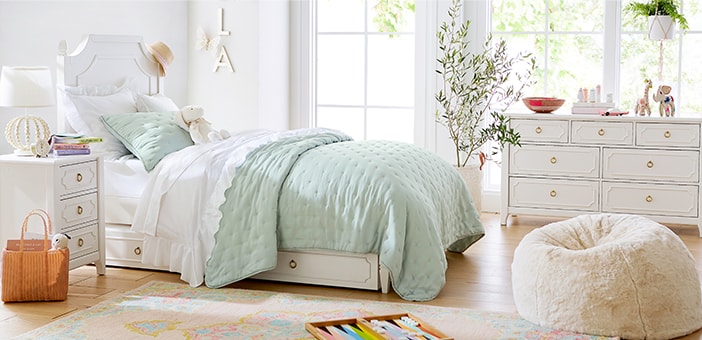Recent studies have shown that sleep is vital for healthy functioning and essential to encourage good sleep habits in young children. Children who get enough sleep have improved immune systems and mental well-being and perform better in school and exhibit superior attitudes, memory, and manners.
However, according to the American Academy of Sleep Medicine, most children nowadays don’t get enough sleep. They have even official recommendations for the quantity of sleep needed to support optimal health in children and teenagers, only to prevent the health risks of insufficient sleep. Children between the ages of 5 and 12 should sleep 9 to 12 hours per day, while infants between the ages of 4 and 12 months should sleep 12 to 16 hours.
What does bedding have to do with sleep quality? Given that little ones will fall asleep easily with soft, airy bedding and pillows that provide a calming, soothing feel, choosing high-quality bedding is critical to support your child’s sleep cycle. So, how can you choose the proper bedding to help your kid sleep?
What Bedding Is Best for Kids?

Since the quality of your children’s bedding can significantly enhance their sleep, opt for lovely childrens bedding designed for superior comfort and a calming, peaceful vibe. The best bedding will help you make your child’s bedroom a safe area where they can unwind, study, and have fun. Comfortable and breathable bed linen in your kids’ favourite colours and patterns can help you create that enchanting, snug atmosphere your kids will love.
What to Consider when Choosing Bedding for Your Kids?
Getting the right size and weave and choosing durable and washable materials that provide the right amount of warmth are crucial factors to consider when shopping for childrens bedding.
Size
For your children’s comfort and to make sustainable and cost-effective decisions, picking the appropriate bed linen size is critical. The main factor to consider when choosing the width of the bedsheets and blankets for your child is whether they sleep in a toddler or full-size bed. Regarding length, picking linens with conventional measurements will help you avoid purchasing new bedding by accommodating your child’s growth for years.
When looking for high-quality children’s bedding online, the most common sizes for bedding sets for kids are single (140×210 cm), double (180×210 cm), and queen (210×210 cm). You can continue your bedding shopping after you’ve determined the size.
Durability
Even the most careful youngster sometimes mistreats their stuff. Ensure your child’s bedding can withstand the excitement, spills, and tears that come with childhood. Fabrics and weaves, among other things, affect how long bedding lasts.
Materials
If you’ve ever told your kids the story of the Three Little Pigs, you’re aware that the material immensely impacts durability. The same is true of your bedding. Although the appearance of polyester bedding may give the idea that it is more robust, natural bedding composed of cotton, bamboo, and silk is far more breathable and typically lasts much longer than synthetic bedding.
Weave
The production technique is equally as important as the materials employed. The strength and quality of the bedding are evident in the weave. Tighter weave fabrics pill less, which means they won’t develop into those little, untidy, rough fibre balls that are uncomfortable for kids to rest on (especially if they have sensitive skin).
The four primary weaves are twill, flannel, percale, and sateen. Although each weave of children’s bedding has benefits and drawbacks, percale is the tightest and least likely to pill.
Washable
Our children’s bedding might get dirty for various reasons, such as midnight bedwetting, juice box spills, and overnight visits from furry pals. As a result, the more filth the bedding accumulates, the more likely the sheets will aggravate allergies and skin irritation.
Everyone wants sheets that can survive the assault of the washing machine, of course. Making something durable is the aim. To find sheets that can be machine washed the most, look for natural materials with long fibres, such as long-fibre cotton.
Warmth
Nobody wants their kids to be awake and shivering in the middle of the night. Thick, well-made linens will help them sleep more peacefully. Purchasing a bedding set with a quilt cover will also enable you to keep the quilt clean.
But just because quilts are typically lighter than duvets doesn’t mean your child won’t have a cold night if they do. Instead of a single duvet, consider layering blankets and throws on your child’s bed to keep them warm and cosy all night.
Design
One of the finest strategies is to choose children’s bedding based on their preferences. Use pillowcases, for instance, with images of their favourite animal, colour, sport, or activity. You may even invest in a sheet set featuring their preferred pastimes or go out with a comforter to match it.
If your child has a bathroom (or shares one with their siblings), think about matching their bed linens with shower curtains and bath towels. Choose a hue or design that is distinctive to your child. Consider purchasing bedsheets, bath towels, and hand towels in the same colour as your child’s favourite colour, in this case, blue. Use humorous patterns like mandalas, checkerboards, or other unusual designs.
Let Your Child Have a Say in the Final Choice

Do you want kids’ bedding that they’ll adore? Just let them speak. Make it a task that will improve relations among you all.
For younger children, choose several items and let them pick their preferences. Give older kids the freedom to decide for themselves. Allow them to pick their bedding at the start and give them a budget to work with.
Tweens and teenagers love being self-reliant. By letting kids select their bedding, you can teach them important life lessons like how to shop.